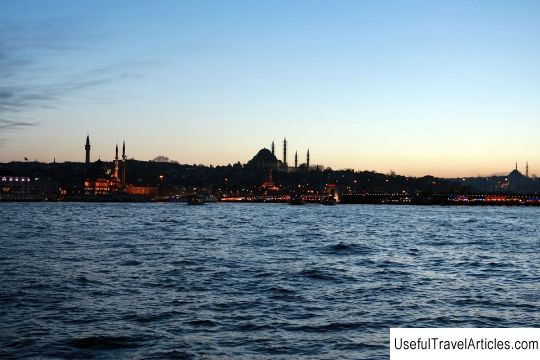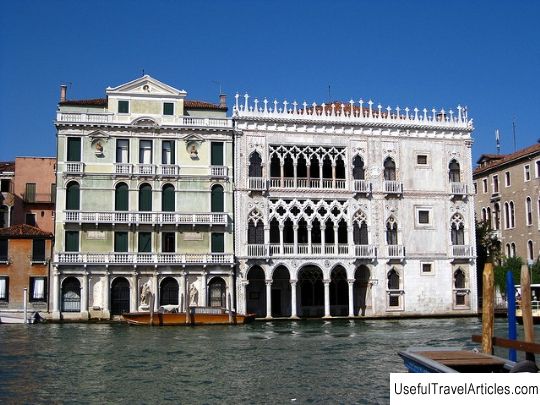Golden Horn (Halic) description and photos - Turkey: Istanbul
Rating: 8,3/10 (3489 votes) 
Golden Horn (Halic) description and photos - Turkey: Istanbul. Detailed information about the attraction. Description, photographs and a map showing the nearest significant objects. The name in English is Halic. Photo & DescriptionGolden Horn is one of the finest natural harbors in the world. In the old days, the Byzantine and Ottoman merchant ships, as well as warships, were stationed here. Today, landscaped parks and pedestrian walkways stretch along the banks. Golden Horn Harbor is a curved bay of the Bosphorus that juts deep into the land. The length of this bay is 12.2 km, width is 91-122 m, depth - 47 m. Two streams flow into the bay in its western part: Ali-bey-su, also called by the ancient Kidaros and Kiat-khane-su - ancient Barbizes ... On both banks is the European part of one of the largest cities in Turkey - Istanbul. Four bridges spanned the bay - this is the Galata Bridge, the Old Galata Bridge, which is no longer in operation, Ataturk Bridge and Halich Bridge. The Golden Horn Bay is protected from all waves and winds, except storm ones. Between Cape Tigrovy and Cape Goldobina, located 1.2 miles from it, it goes deep into the northern coast of the Bosporus-Vostochny Strait. The bay is bounded by the Shkot peninsula located in the northwest. This shore of the Golden Horn is very hilly, and its southern part is steep and deeper throughout. The northern, southern and eastern coasts of the bay are elevated, but in some places they also have cliffs and are framed by a low and very narrow coastal strip, which has been artificially leveled and in places expanded for port facilities. The coast of the top of the bay is low. A valley comes out to it, along which the Explanation river flows. Somewhere about seven thousand years ago, the waters of the Bosphorus and the rivers Kagytkhane and Alibey, still flowing into the Golden Horn (its northern part), merged and formed a natural harbor. For centuries, the Golden Horn or Altin Boynuz has been called one of the best natural harbors in the world. The waters of this bay, which really resembles a horn in shape, were full of fish, and the very fertile land along the banks of the harbor gave very rich harvests. The bay was often called the cornucopia, and it is also believed that this bay was named by Byzantium himself after his mother, whose name was Keroessa, because in Greek the Golden Horn sounds like Krisokeras. There is, however, another interesting legend, which says that under the rays of the shining sun, the waters of the bay sparkle with real gold. The current Turkish name for the Golden Horn is Halich (halic, which means “bay” in Turkish). The full name of this harbor comes from the Ottoman Halich-i Dersaadet, which means `` Bay of the Gate of Bliss. '' The summer weather in the Golden Horn is very changeable. Southerly and southeasterly winds prevail here, it often rains and fogs appear. In autumn and winter, winds mainly blow from the north and northwest. They bring dry and clear weather with a large drop in air temperature, with an increase in atmospheric pressure. Fogs in Golden Horn harbor are observed from April to August. They are most often seen in June - July. Fogs tend to appear here when southeasterly winds blow. When there is complete calm, they can be seen much less often. Winds blowing in autumn and winter are very long-lasting and sometimes can reach speeds of 6-8 m / s or more, and in spring and summer the wind speed is slightly less. In the Fener and Balat districts, which are comfortably located in the heart of the Golden Horn, there are numerous streets of ancient houses and churches, synagogues, erected in the era of the Ottoman and Byzantine empires. The shores of the Golden Horn Bay are fortified, practically along its entire length, by walls. They are equipped with piers and moorings. The depth at the entrance to the Golden Horn ranges from 20 to 27 m and further, to the top of the bay, it gradually decreases. The ground in the bay is silt. When the Turks came here, the shores of the Golden Horn turned into a popular vacation spot. Rich mansions and summer residences began to be built here. But, despite this, over time, a large number of workshops and factories began to appear on these lands. Uncontrolled industrial development gradually led to terrible environmental pollution and the waters of the Golden Horn turned into a real cesspool. The city sewage and industrial waste was merged here by all who were not lazy. The situation changed for the better only in the 1980s. The municipality of Istanbul has decided to return this ancient area of the city to its former beauty. At present, green cozy parks and its coastal quarters have again spread along the banks of the Golden Horn, which still retain on their streets wooden houses built in the Byzantine and Ottoman periods, synagogues and churches, and the sunset again covers the waters of this beautiful bay with gold. p> The city sewage and industrial waste was merged here by all who were not lazy. The situation changed for the better only in the 1980s. The municipality of Istanbul has decided to return this ancient area of the city to its former beauty. At present, green cozy parks and its coastal quarters have again spread along the banks of the Golden Horn, which still retain on their streets wooden houses built in the Byzantine and Ottoman periods, synagogues and churches, and the sunset again covers the waters of this beautiful bay with gold. p> The city sewage and industrial waste was merged here by all who were not lazy. The situation changed for the better only in the 1980s. The municipality of Istanbul has decided to return this ancient area of the city to its former beauty. At present, green cozy parks and its coastal quarters have again spread along the banks of the Golden Horn, which still retain on their streets wooden houses built in the Byzantine and Ottoman periods, synagogues and churches, and the sunset again covers the waters of this beautiful bay with gold. p>       We also recommend reading Khuzaifa ibn al-Yamani mosque description and photos - Russia - Volga region: Kazan Topic: Golden Horn (Halic) description and photos - Turkey: Istanbul. |




